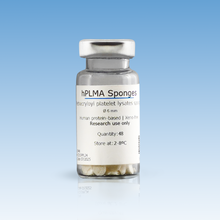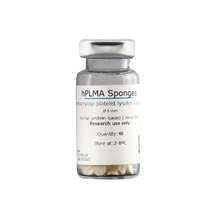
Introduction
Metatissue® hPLMA Sponge is a human based, xeno-free, bioactive platelet lysates-derived platform that provides physiologically relevant microenvironments for cell culture. hPLMA Sponge is a porous scaffold, ready to use, with high reproducibility and increased area for cell growth and migration. hPLMA Sponge is designed to be suitable for 96 well-plates and no photoinitiator or light source is needed.
Description
hPLMA Sponge is an innovative porous scaffold designed for ready-to-use, advanced 3D cell culture applications. These sponges offer a unique combination of structural support and bioactivity, making them ideal for replicating the complex microenvironments found in vivo. The porous architecture of hPLMA Sponge promotes efficient cell infiltration, nutrient diffusion, and waste removal, which are critical for maintaining cell viability and function in three-dimensional cultures. In tissue engineering and regenerative medicine, the ability to culture cells in 3D is essential for mimicking the natural cell environment and studying cellular behaviors, interactions, and responses more accurately than traditional 2D cultures.
hPLMA Sponge, derived from human methacryloyl platelet lysate (hPLMA), provides a xeno-free, biocompatible platform that supports cell attachment, proliferation, and differentiation even without traditional animal derived supplementation. This makes them particularly useful for a variety of applications, including drug screening, disease modeling, and the development of tissue-engineered constructs.
Advantages:
- Human-derived: Multiple native human-derived proteins and growth factors provide a xeno-free alternative to animal products.
- High reproducibility.
- Enhanced surface area for cell attachment, growth, and migration.
- Physiologically relevant microenvironments that support advanced cell culture applications.
- Designed to be suitable for 96 well-plates.
- No photoinitiator or light source is needed.
hPLMA Material
Metatissue® hPLMA Sponge derinved from hPL is composed of several proteins, including growth factors and cytokines. These bioactive proteins are known to be key components involved in cell adhesion and proliferation processes and are major regulators of angiogenesis.
Identified Growth Factors:
- Platelet-derived growth factor (PDGF)
- Vascular endothelial growth factor (VEGF)
- Erythropoietin (EPO)
- Epidermal growth factor (EGF)
- Hepatocyte growth factor (HGF)
Source:
hPLMA is manufactured from platelet units obtained from screened healthy donors designated for therapeutic transfusion. Each donor undergoes testing, and non-reactivity is confirmed for HBsAg, anti-HBc, anti-HIV-1/2, anti-HCV, anti-HTLV-1/2, anti-T. cruzi, HIV-1, HCV, HBV, WNV nucleic acid testing, and syphilis micro hemagglutination assay. It is essential to observe universal precautions for handling and disposing of biological products while working with hPLMA.
Specifications
| Product Category: | Hydrogels, scaffolds, biomatrices |
|
Product Type: |
Scaffold |
| Format: | Designed to fit 96-well microplates. |
| Size: | 48 ct. |
| Storage: | 2-8°C |
| Manufacturer: | Metatissue® |
| Country of Origin: | Portugal |
Porous structure and swelling rate
hPLMA Sponges have a porous internal structure. The pore size of hPLMA sponges is approximately 25 ± 5 µm. The maximum swelling of the sponges is achieved after approx. 5 min (in PBS) and they present a Young modulus around 13 KDa.

Figure 1. hPLMA Sponge scaffold internal structure. Scale bar: 300 μm.
Validation in Cell Culture
Cell viability and proliferation: with or without FBS supplementation.
hPLMA-based sponges offer a robust and ethical platform for 3D cell culture, supporting the adhesion, proliferation, and network formation of human adipose-derived stem cells (hASCs) for up to 14 days without the need for animal-derived serum supplementation.

Figure 2. Representative fluorescence images for hASCs cultures in hPLMA Sponge of live/dead and DAPI/Phalloidin staining.
Unlike traditional collagen-based sponges, which typically require fetal bovine serum (FBS) to promote cell attachment and spreading, hPLMA Sponges inherently enable effective cell anchorage and the formation of well-organized, interconnected cellular networks. This is confirmed by F-actin and DAPI staining, along with live/dead assays showing sustained cell viability and metabolic activity throughout the culture period.

Figure 3. Cell proliferation and viability assessment. a) DNA, and b) MTS results for hASCs after 3, 7, and 14 days of cell culture with and without animal-derived serum supplement.
The functional performance of hPLMA Sponge is attributed to their natural content of bioactive proteins and growth factors, as demonstrated by the LEGENDplex™ Human Growth Factor Panel. This intrinsic bioactivity supports hASC proliferation and viability over extended periods, eliminating the need for xenogeneic components.

Figure 4. hPLMA growth factors quantification and protein release profile of hPLMA Sponge. a) Quantification of hPLMA growth factors by LEGENDplex Human Growth Factor Panel. b) Mass loss (%) of hPLMA Sponge. c) Total protein release quantification of hPLMA Sponge. Protein release assays were performed with PLMA during 14 days.
By reducing reliance on animal-derived supplements and minimizing the risk of xenogeneic contamination, hPLMA-based sponges present a clinically translatable, xeno-free alternative for tissue engineering, regenerative medicine, and advanced in vitro models.
Documents
Usage
This product is intended for Laboratory Research Use Only. Not for use in diagnostic or therapeutic procedures. This product may not be used as a pharmaceutical or veterinary drug, agricultural product, or food additive.
Related Products
Ilex Life Sciences LLC is an authorized worldwide distributor of Metatissue® products.




